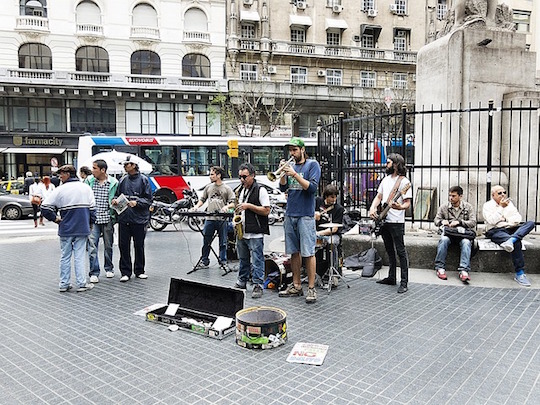
by Paul Mains from Language Trainers
If you’re listening to Argentinian Spanish for the first time, it might sound like a completely different language -- not only is there distinct pronunciation and vocabulary, as is common in different Spanish dialects, but there are even unique grammatical rules and verb conjugations. Luckily, there is plenty of great Argentinian music that can help you get accustomed to all the features of Argentinian Spanish, which will be an immense help when you start conversing with the locals.
1. Perfect Your Accent With La Flor Más Bella
One of the most distinctive qualities of the Argentinian dialect is the pronunciation of the letters "Y" and "LL": in Argentina, they’re pronounced like the “sh” in “sheep”. This can be disorienting to those of us who have learned the pronunciation of other Spanish dialects, in which these letters sound like the “y” in “yes”.
The catchy, romantic rock tune La Flor Más Bella (“The Most Beautiful Flower”) is a love song to a particularly beautiful woman, and doubles as a great way to get used to how Argentines pronounce sounds. In the first three lines alone, there are four instances of the Argentinian “sh” sound:
Ella es la flor más bella
Vagando por las estrellas
Brilla más que el sol
Listen to it a few times, and you’ll no longer be bewildered when an Argentin asks you, “¿Cómo te shamas?” Indeed, the lyrics are simple and easy to learn, so after hearing the song a couple times, try singing along -- you’ll sound like a native in no time.
2. Hone Your Grammar Skills With Ciudad Mágica
For English speakers, one of the hardest parts about learning Spanish is memorizing all of the verb conjugations for the seemingly infinite number of tenses and moods. Well, with Argentinian Spanish, you have even more to learn!
Argentina (as well as several other countries in Central America and on the Atlantic Coast of South America) employs voseo, which means that they don’t use tú as a second-person pronoun, but rather use vos. And it’s not just the pronoun that’s different: vos comes with a unique set of conjugations in the present tense, as well as an entirely different set of affirmative commands.
You can see voseo in action with the catchy anthem Ciudad Mágica (“Magical City”), which is Buenos Aires’ answer to city-themed serenades such as Frank Sinatra’s New York, New York. In it, you’ll both get both a grammar lesson as well as a taste for Buenos Aires’ one-of-a-kind nightlife.
Y está muy bien así,
Por hoy no pienses más
Yo sé que lo necesitás
Me quedo con vos, te sigo de largo, voy a buscarte
The song’s chorus serves as a primer for basic voseo: you don’t say contigo, but rather con vos; second-person verbs don’t have stem-changes, and always have the stress on the final syllable -- it’s necesitás, not necesitas; it’s tenés, not tienes; it’s venís, not vienes. And in the song’s verses, you get a more advanced crash-course in commands:
Dejá que la noche nos proponga más
Decime que sí, hacé como yo
With voseo, you can forget about all the pesky rules and exceptions for forming commands in Spanish: you simply take the infinite form, drop the “r”, and put the emphasis on the final syllable. Thus, it’s dejá, not deja; it’s decime, not dime; it’s hacé, not haz.
3. Learn Lunfardo With Milonga Lunfarda
Even veteran Spanish speakers might get lost with the uniquely Argentinian slang known as lunfardo, which developed in the late 19th century in the lower-class neighborhoods in and around Buenos Aires. Luckily, a classic Argentinian tango called the Milonga Lunfarda will explicitly teach you how to use all the most common slang of lunfardo.
So if you feel like a chabón when your Argentinian friends complain about chorros or long for more guita, look no further than the first few lines of Milonga Lunfarda:
El que roba es él que afana, el chorro un vulgar ladrón
El zonzo llaman chabón y al vivo le baten rana
La guita o el vento es el dinero que circula
El cuento es meter la mula, y al vesre por al revés.
The tango is light-hearted and easy on the ears, but is also chock-full of useful Argentinian slang, and will surely make conversations between natives much easier to follow. You could even try surprising your friends by busting out some lunfardo that you learn from the song -- they’ll surely be impressed (or at least amused)!
Given the rich musical tradition in Argentina, you can pick up on the dialect without ever cracking open a book -- there’s a plethora of high-quality Argentinian music that will get you well acquainted with Argentinian Spanish, from its formal grammatical rules to its street slang. In many ways, Argentinian Spanish is like Argentina itself: complex, unusual, and full of character and life. Indeed, its uniqueness within the Spanish-speaking world makes it hard to learn, but is also the reason that learning Spanish in Argentina is so fun, challenging, and rewarding.

Paul writes for Language Trainers, which provides individually-tailored language training on a one-on-one or small group basis worldwide. Language Trainers offers several free educational resources, such as Spanish-language level tests and listening tests. Don’t hesitate to visit Language Trainers' Facebook page for more information.